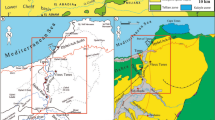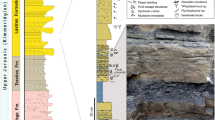Abstract
A neoichnological study was done at a site west of Abha on the southern Red Sea coast of Saudi Arabia. This area covers Wadi Hali and its surroundings (180 49′35.27″N: 410 22′44.23″E). The objective of the study is to document biogenic traces that occur in the upper intertidal ripple-marked sand flats and supratidal flats that include microbial mats, mud flats, and scattered patches of mangrove stands and their muddy environments. Based on morphological descriptions, four different kinds of burrows are identified and their fossil equivalents are Psilonichnus upsilon (burrow type 1), Cylindricum (burrow types 2 and 3), and Arenicolites (burrow type 4). Tracks of land hermit crabs Coenobita clypeatus are described as ichnospecies Coenobichnus currani. Gastropod grazing trails and their fossil equivalent Planolites is identified as well. Supratidal algal mats and their microscopic contents are presented. Fossil plant roots (rhizomes) are reported from a localized fluvial deposit from a dry channel (wadi). The morphology of the traces, trace maker, and ethology and the environmental setting indicate that the ichnofauna and botanical traces belong to the Psilonichnus ichnofacies.





Similar content being viewed by others
References
Bertling M, Brady SJ, Bromley RG, Demathieu GR, Genise J, Mikuláš R, Nielsen JK, Nielsen KKS, Rindsberg AK, Schlirf M, Uchman A (2006) Names of trace fossils: a uniform approach. Lethaia 39(3):265–286. https://doi.org/10.1080/00241160600787890
Bockelie JF (1994) Plant roots in core. In: Donovan SK (ed) The Palaeobiology of trace fossils. Johns Hopkins University Press, pp 177–199
Baucon A (2008) Neoichnology of a microbial mat in a temperate, siliciclastic environment: Spiaggia al Bosco (Grado, northern Adriatic, Italy). Studi Trent Sci Nat Acta Geol 83:183–203
Bromley RG (1990) Trace fossils: biology and taphonomy. Special topics in Palaeontology. Unwin Hyman, London
Buatois L Mángano MG (2011) Ichnology, organism-substrate interactions in space and time. Cambridge University Press, DOI: https://doi.org/10.1017/CBO9780511975622
Chakrabarti A (1981) Burrow pattern of Ocypode ceratophthalma (Pallas) and their environmental significance. J Paleontol 187:113–113
Chan BKK, Chan KKY, Leung PCM (2006) Burrow architecture of the ghost crab Ocypode ceratophthalma on a sandy shore in Hong Kong. Hydrobiol 560(1):43–49. https://doi.org/10.1007/s10750-005-1088-2
Curran HA (1994) The palaeobiology of ichnocoenoses in quaternary, Bahamian-style carbonate environments: the modern and fossil transition. In: Donovan SK (ed) Palaeobiology of trace fossils. John Wiley & Sons, pp 83–194
Curran HA (2008) Ichnofacies, Ichnocoenoses, and ichnofabrics of quaternary shallow marine to dunal tropical carbonates: a model and implications. In: Miller W III (ed) Trace fossils, concepts, problems, prospects. Elsevier, pp 232–247
Dashtgard SE, Gingras MK (2012) Marine invertebrate Neoichnology (chapter 10). In: Knaust D, Bromley RG (eds) Trace fossils as indicators of sedimentary environments. Developments in sedimentology, Elsevier, 64, pp 273–295. https://doi.org/10.1016/B978-0-444-53813-0.00010-1
Desjardins PR, Buatois LA, Mángano MG (2012) Tidal flats and supratidal sand bodies (chapter 18). In: Knaust D, Bromley RG (eds) Trace fossils as indicators of sedimentary environments. Developments in sedimentology, Elsevier, 64, pp 529–562. https://doi.org/10.1016/B978-0-444-53813-0.00018-6
El-Hedeny M, Hewaidy AGAH, Al-Kahtany K (2012) Shallow-marine trace fossils from the Callovian-Oxfordian Tuwaiq Mountain limestone and Hanifa formations, central Saudi Arabia. Australian J Basic Applied Sci 6(3):722–733
Frey RW, Pemberton SG (1987) The Psilonichnus ichnocoenose, and its relationship to adjacent marine and nonmarine ichnoecenoses along the Georgia coast. Bull Can J Petrol Geol 35:333–357
Frey RW, Curran HA, Pemberton SG (1984) Trace making activities of crabs and their environmental significance: the ichnogenus Psilonichnus. J Paleontol 58:333–350
Garrison JR, Henk B, Creel R (2007) Neoichnology of the micro-tidal Gulf Coast of Texas: implications for Paleoecological and Paleoenvironmental interpretations of ancient micro-tidal clastic shoreline systems. Gulf Coast Asso Geol Soc Ann Meeting Trans 2007, 15p
Jado AR, Zölt JG (1984) Quaternary period in Saudi Arabia, vol 2. Springer-Verlag, New York. https://doi.org/10.1007/978-3-7091-8711-1
Jado AR, Hötzl H, Roscher B (1990) Development of sedimentation along the Saudi Arabian Red Sea coast. JKAU earth Sci 3, Spe issue: 1st Saudi Symp Earth Sci Jeddah 1989:47–62
Khan AM, Kumar A, Muqtadir A (2010) Distribution of mangroves along the Red Sea coast of the Arabian Peninsula: Part 2. The Southern Coast of Western Saudi Arabia. Open Access e-J Earth Sci India 3(III):154–162
Knaust D, Curran HA, Dronov AV (2012) Shallow marine carbonates (chapter 23). In: Knaust D, Bromley RG (eds) Trace fossils as indicators of sedimentary environments. Developments in sedimentology. Elsevier, pp 705–750. https://doi.org/10.1016/B978-0-444-53813-0.00023-X
Kumar A, Khan MA, Muqtadir A (2010) Distribution of mangroves along the Red Sea coast of the Arabian peninsula: Part-1: the northern coast of western Saudi Arabia. Open Access e-J Earth Sci India 3(1):28–42
Kumar A, Khan MA, Muqtadir A (2011) Distribution of mangroves along the Red Sea coast of the Arabian Peninsula: Part-3: the coast of Yemen. Open Access e-J Earth Sci India 4(II):29–38
MacEachern JA, Pemberton SG, Gingras MK, Bann KL (2008) The ichnofacies paradigm: a fifty year retrospective (chapter 4). In: Miller W III (ed) Trace fossils, concepts, problems, prospects. Elsevier, pp 52–77
MacEachern JA, Bann KL, Gingras MK, Zonneveld JP, Dashtgard SE, Pemberton SG (2012) The ichnofacies paradigm (chapter 4). In: Knaust D, Bromley RG (eds) Trace fossils as indicators of sedimentary environments. Developments in sedimentology. Elsevier, pp 103–138. https://doi.org/10.1016/B978-0-444-53813-0.00004-6
Pemberton SG, Spila M, Pulham AJ, Saunders T, MacEachern JA, Robbins D, Sinclair IK (2001) Ichnology and sedimentology of shallow to marginal marine systems. Ben Nevis & Avalon Reservoirs, Jeanne d’Arc Basin. Geol Assoc Canada. Short Course Notes 15:1–341
Prinz WC (1984) Explanatory notes to the geologic map of the Wadi Haliy quadrangle, sheet 18E, Kingdom of Saudi Arabia (to accompany map GM-74 a.C.). Ministry petrol min res, Jeddah, Saudi Arabia, pp 1–13
Radiesa D, Hasiotisb ST, Preusserb F, Neubertc E, Mattera A (2005) Paleoclimatic significance of early Holocene faunal assemblages in wet interdune deposits of the Wahiba Sand Sea, Sultanate of Oman. J of Arid Environ 62(1):109–125. https://doi.org/10.1016/j.jaridenv.2004.09.021
Rindsberg AK (2012) Ichnotaxonomy: finding patterns in a welter of information (chapter 2). In: Knaust D, Bromley RG (eds) Trace fossils as indicators of sedimentary environments. Developments in sedimentology. Elsevier, pp 45–78. https://doi.org/10.1016/B978-0-444-53813-0.00002-2
Sakai K, Türkay M (2013) Revision of the genus Ocypode, with the description of a new genus Hoplocypode (Crustacea: Decapoda: Brachyura). Mem Queensland Mus-Nature 56(2):665–793
Sarjeant WAS (1975) Plant trace fossils. In: Frey RW (ed) The study of trace fossils. Springer-Verlag, New York, pp 163–169. https://doi.org/10.1007/978-3-642-65923-2_10
Seike K, Nara M (2007) Occurrence of bioglyphs on Ocypode crab burrows in a modern sandy beach and its palaeoenvironmental implications. Palaeogeog Palaeoclimatol Palaeoecol 252(3-4):458–463. https://doi.org/10.1016/j.palaeo.2007.05.003
Seilacher A (1953a) Studien zur Palichnologie. I Über die Methoden der Paliichnologie N Jb Geol Paläont Abh 96:421–452
Seilacher A (1953b) Studien zur Palichnologie. II. Die fossilien Ruhespuren (Cubichnia). N Jb Geol Paläont Abh 98:87–124
Shapiro RS (2008) Stromatolites: a 3.5 billion year Ichnological record (chapter 22). In: Miller IIIW (ed) Trace fossils, concepts, problems, prospects. Elsevier, pp 382–390
Smith CR, Levin LA, Hoover DJ, McMurtry G, Gage JD (2000) Variations in bioturbation across the oxygen minimum zone in the northwest Arabian Sea. Deep-Sea Research II 47(1-2):227–257. https://doi.org/10.1016/S0967-0645(99)00108-3
Tyler-Walters H (2001) Arenicola marina Blow lug. marine life information network: biology and sensitivity key information sub-programme [on-line]. Plymouth: Marine Biological Association of the United Kingdom. (November, 2002) http://www.marlin.ac.uk/species/Arenicolamarina.htm
Volkenborn N (2005) Ecosystem engineering in intertidal sand by the lugworm Arenicola marina.(http://evolutionbiology.com/articles/life-history-traits-of-the-lugworm-arenicola-marina)
Walker SE, Hollanda SM, Gardinera L (2003) Coenobichnus currani (new ichnogenus and ichnospecies): fossil trackway of a land hermit crab, early Holocene, San Salvador, Bahamas. J Paleontol 77(3):576–582. https://doi.org/10.1017/S0022336000044255
Whybrow PJ, McClure HA (1980) Fossil mangrove roots and palaeoenvironments of the Miocene of the eastern Arabian peninsula. Palaeogeogr Palaeoclimatol Palaeoecol 32:213–225. https://doi.org/10.1016/0031-0182(80)90041-3
Acknowledgements
I thank my former colleagues at King Fahad University of Petroleum and Minerals (KFUPM), Saudi Arabia. They are Drs. Osman Abdullatif, Khalid Al-Ramadan, Lamidi O. Babalola, Michael A. Kaminski, and Asif M. Khan; I thank them for their help in the field and for discussing the geology of the area. I also thank KFUPM for funding our travel to the area of the study. I thank my son Anshuman Kumar for linguistic improvements to this paper.
Author information
Authors and Affiliations
Corresponding author
Rights and permissions
About this article
Cite this article
Kumar, A. Recent biogenic traces from the coastal environments of the southern Red Sea coast of Saudi Arabia. Arab J Geosci 10, 500 (2017). https://doi.org/10.1007/s12517-017-3293-5
Received:
Accepted:
Published:
DOI: https://doi.org/10.1007/s12517-017-3293-5




